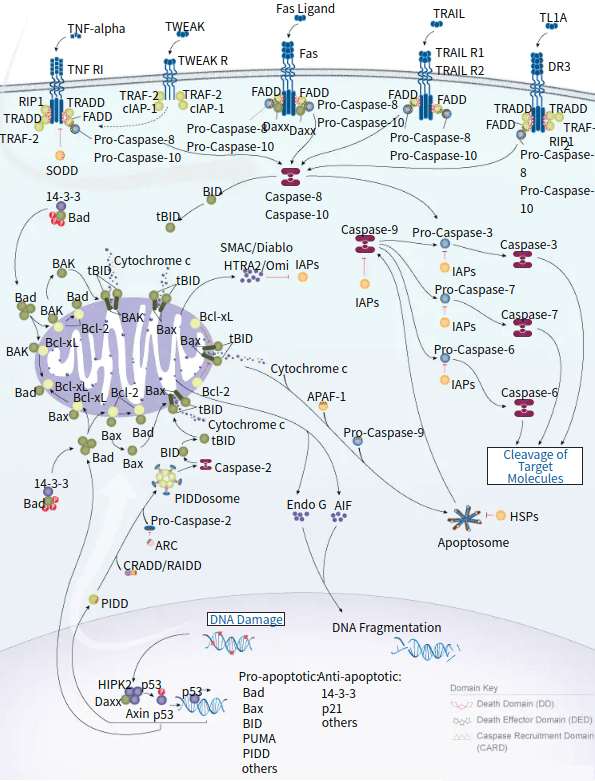Introduction to apoptosis signaling pathway
Based on Luminex technology platform, Creative Proteomics provides analysis services for key targets of apoptosis signaling pathway.
 Apoptosis is the process of programmed cell death characterized by distinct morphological characteristics and energy-dependent biochemical mechanisms. Apoptosis is considered a vital component of processes including normal cell turnover, proper development and functioning of the immune system, hormone-dependent atrophy, embryonic development and chemical-induced cell death.
Apoptosis is the process of programmed cell death characterized by distinct morphological characteristics and energy-dependent biochemical mechanisms. Apoptosis is considered a vital component of processes including normal cell turnover, proper development and functioning of the immune system, hormone-dependent atrophy, embryonic development and chemical-induced cell death.
Apoptotic cells undergo morphological changes involving extensive plasma membrane blebbing followed by karyorrhexis. Apoptotic bodies are formed by separation of cell fragments during a process called "budding". Apoptotic bodies consist of cytoplasm with tightly packed organelles with or without a nuclear fragment. The organelle integrity remains enclosed within an intact plasma membrane. These bodies are subsequently phagocytosed by macrophages, parenchymal cells, or neoplastic cells and degraded within phagolysosomes. There are three main types of biochemical changes observed in apoptosis:
- Activation of caspases
- Breakdown of DNA and protein and
- Membrane changes and recognition by phagocytic cells.
The two most widely characterised apoptotic pathways are the Intrinsic and Extrinsic pathways.
- The extrinsic signaling pathways involve transmembrane death receptors that are members of the tumor necrosis factor (TNF) receptor gene superfamily. Characterized ligands and corresponding death receptors include FasL/FasR, TNF-α/TNFR1, Apo3L/DR3, Apo2L/ DR4 and Apo2L/DR5.
- The intrinsic signaling pathways that initiate apoptosis are mitochondrial-initiated events involving a diverse array of non-receptor-mediated stimuli. These stimuli cause changes in the inner mitochondrial membrane that result in an opening of the mitochondrial permeability transition (MPT) pore, loss of the mitochondrial transmembrane potential and release of two main groups of normally sequestered pro-apoptotic proteins from the intermembrane space into the cytosol. These proteins activate the caspase- dependent mitochondrial pathway. Cytochrome C binds and activates Apaf-1 as well as procaspase-9, forming an "apoptosome". The control and regulation of these apoptotic mitochondrial events occurs through members of the Bcl-2 family of proteins. The tumor suppressor protein p53 has a critical role in regulation of the Bcl-2 family of proteins.
Our detectable targets:
| p53 | BID | IAPs | tBID | SODD | Bad |
| BAK | Bax | PIDD | MYD88 | Rac1 | TLR4 |
| Bcl-xl | RIP1 | TRAF-2 | FADD | APAF-1 | BID |
| FADD | IRF7 | Mda-5 | NFκB | RIG-1 | TRAF3 |
| GAS | IRF9 | MEKK1 | p38 | RIP1 | TRAF5 |
| Histone-H3 | IRF5 | MEK3 | p38MAPK | SH2 | TRAF6 |
| IKK-α | IRS1 | MEK6 | p50 | SLP76 | TRAM |
| IKK-β | IRS2 | MSK1 | p65 | Tak1 | TRIF |
| IPS-1 | ISGF3 | MSK2 | PI3K | TBK1 | Vav |
| IRAK1 | ISRE | mTOR | PKR | TLR3 |
Technology platform:
We provide Luminex technology for apoptosis signaling pathway analysis.
Luminex technology is a multifunctional liquid phase analysis platform developed on the basis of colored microspheres, laser technology, applied fluidics and high-speed digital signal processing technology. The core is to encode polypropylene microspheres or magnetic microspheres with fluorescent dyes. By adjusting the different ratios of the two fluorescent dyes, up to 100 microspheres with different fluorescence spectra can be obtained. Antigen-antibody, enzyme-substrate, ligand-receptor binding reactions and nucleic acid hybridization reactions are performed on microspheres with different fluorescence encoding. Qualitative and quantitative analysis by laser detection of microsphere coding and reporter fluorescence separately.
Apoptosis signal pathways mainly include endogenous and exogenous signal pathways. This pathway is widely used in cell renewal, normal development and function of the immune system, hormone-dependent atrophy, embryonic development and chemically induced cell death.
In addition to Luminex Multiplex Assay, Enzyme-linked immunosorbent assay (ELISA), Flow cytometry (FACS analysis) technology can also be provided to meet other customer needs.
Advantages of apoptosis signaling pathway detection:
- High-throughput and high-speed: Each microsphere is used as a separate test body, which can perform a large number of biological tests at the same time. It only needs 10~201 samples to test up to 100 indicators at a time, and the fastest can reach 10,000 tests /hour.
- Good repeatability: The Luminex detection platform directly reads the fluorescence value, which is more stable and sensitive: 100 microspheres of each type are detected, and the median value is taken as the result, which is equivalent to 100 repeated detections for each sample.
- Low cost: Simultaneous detection of multiple indicators of a sample can save time, samples, reduce detection costs, and improve analysis efficiency.

Application of our service:
- To study the regulation mechanism of apoptosis signal pathway in disease
- To study the effect of each virus on apoptosis signaling pathway
- To study the effects of drugs or therapies on apoptosis signaling pathways
Creative Proteomics has developed a signal pathway target detection platform. We are not limited to providing apoptosis signal path detection services, but can also provide other signal path detection services. If you want to detect other targets, please contact us and we will customize the service for you. Look forward to working with you.
References:
- Ouyang, L. et al. Programmed cell death pathways in cancer: a review of apoptosis, autophagy and programmed necrosis. Cell Proliferation, 2012, 45, 487-498.
- Ichim, G., Tait, S. W. G. A fate worse than death: apoptosis as an oncogenic process. Nature Reviews Cancer, 2016, 16: 539-548.



